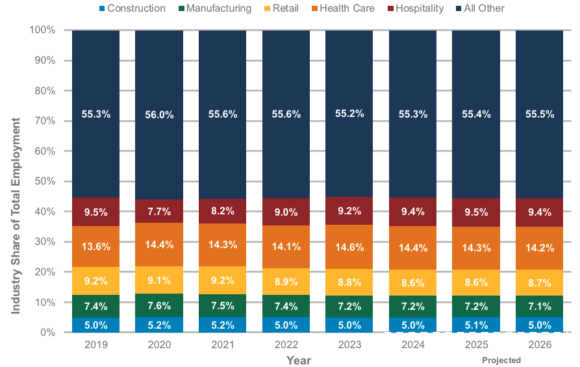California
Over 100 horses at Southern California facility at risk of being displaced

More than 100 horses are in danger of being displaced, including some that are too old to be moved and would need to be euthanized, after the city of Lakewood announced it could no longer afford to run the beloved equestrian center.
The Lakewood Equestrian Center also houses miniature horses and some mules. Some of the horses are old and have been retired, while others are used for training and riding.
Taylor Cohen, who works as a first responder and boards her horse at the center, explained that horses provide people with the opportunity to relax and just love their animals.
Hearing news that the city plans to shutter the equestrian center, she said, was devastating.
“Having been a first responder [for] the last 18 years of my life, finding ways to manage the stress that you come into is huge,” Cohen explained. “There has to be other ways [to do that] besides going and seeing a therapist.”
Part of the land the equestrian center sits on is owned by the county. Another portion is owned by Southern California Edison.
The city has announced plans to wipe the equestrian center out and build a park with pickleball courts, though, according to Cohen and others, this comes with a huge problem.
“There’s nowhere for these horses to go,” she said. “Some of them won’t be able to be moved because of age or health issues. There’s actually no place around that will be able to board all these horses.”
Lakewood City Council halted their vote on the issue to give people more time to come up with a proposal for taking it over, but the facility needs at least $6 million in repairs and Edison is owed more than $40,000 on the lease, leaving some people who use the center at a loss.
“We have nowhere else to go,” Noah Grove, who boards his animals at the facility, told KTLA’s Jennifer McGraw. “Huntington Beach Equestrian Center, their full and have a 35-horse waitlist. I’m actually from Huntington Beach. I drive 18 to 30 minutes to get here, depending on traffic, and I’m up here sometimes twice a day.”
Riders like Makella Mahan are hoping someone can grab the reins of the facility and save this haven for her and the horses.
“Honestly, all these beautiful horses would be out of a home, and I think that would be very sad,” she said.
For its part, city officials have said they don’t necessarily want to close the facility and are hoping to come up with a plan, along with the equestrian community, for making the center profitable or even getting it to break even.

California
California’s second largest reservoir is shrinking

A new study from California’s Department of Water Resources (DWR) has found that Lake Oroville is shrinking.
Water levels at the state’s second largest reservoir are in a much better place than they were two years ago, when severe drought gripped much of California. Two back-to-back wet winters, accompanied by atmospheric rivers, have supplemented the water levels at many California reservoirs and contributed greatly to their recovery, although the atmospheric rivers also caused flooding and mudslides.
Atmospheric rivers are a “long, narrow region in the atmosphere—like rivers in the sky—that transport most of the water vapor outside of the tropics,” according to the National Oceanic and Atmospheric Administration.
Despite Lake Oroville’s recovery, water officials recently discovered that its capacity was shrinking and that the lake had lost 3 percent of capacity since it was created in the 1960s.
Getty
“DWR utilized the latest terrain-mapping technology to determine if there have been any changes in the lake’s volume to optimize how the reservoir is operated and ensure accuracy in estimating California’s water supply availability,” a DWR webpage said.
“What resulted were highly detailed 3D topographic terrain models of the bottom of the lake, which DWR engineers used to calculate a new storage capacity of 3,424,753 acre-feet, approximately 3 percent less than previously estimated,” the webpage added.
The DWR attributed the loss to “weather swings and almost six decades of service.” Newsweek reached out to the DWR by email for comment.
Despite the loss, DWR officials said Lake Oroville remains the state’s second largest reservoir, behind only Lake Shasta.
“Having updated storage capacity data allows us to operate Lake Oroville in a more efficient manner,” said John Yarbrough, the DWR’s deputy director of the State Water Project.
“It ensures we are providing adequate flood storage protection during winter months and accurately accounts for the state’s water supply, which is especially important as we experience climate change-driven weather extremes,” he said.
During the winter months, water officials occasionally release water from the reservoir to provide flood mitigation for downstream communities, such as in February when atmospheric rivers brought a deluge of rain to the area. Once California enters its dry season, officials transition to retaining as much water as possible in the reservoir.
Lake Oroville’s water levels began rising last December and reached full capacity in May. The levels have been steadily declining over the past few weeks as California enters its dry season.
However, the lake is in a much better state than it was in 2022. As of Tuesday, Lake Oroville’s water levels were at 887 feet, only 12 feet below full pool of 900 feet. During the summer of 2022, the water levels were at only 750 feet.
Uncommon Knowledge
Newsweek is committed to challenging conventional wisdom and finding connections in the search for common ground.
Newsweek is committed to challenging conventional wisdom and finding connections in the search for common ground.
California
Fossil fuel groups ask SCOTUS to overturn California’s clean car waiver

Fossil fuel interests want the Supreme Court to review California’s authority to set stricter emissions standards for cars and trucks than the federal government.
A petition to be filed Tuesday asks the high court to overturn an April ruling by the U.S. Court of Appeals for the District of Columbia Circuit. The judges unanimously ruled that industry groups and a coalition of Republican-led states had failed to show that a favorable ruling would fix the injuries they claimed from California’s waiver.
The petitioners to the Supreme Court include the American Fuel & Petrochemical Manufacturers (AFPM), the Domestic Energy Producers Alliance, Energy Marketers of America, the National Association of Convenience Stores, and a number of biofuel and agricultural organizations.
They argue that the D.C. Circuit — which found that the challengers lacked standing to bring their claim — failed to consider the substance of the case. The challengers ask the Supreme Court to review the merits and find that California’s waiver does not empower the state to regulate vehicle greenhouse gas emissions, impose electric vehicle mandates or limit consumer access to internal combustion engines.
California
Report Keys on Impacts of Economic Changes on California Workers' Comp

Projected changes to California workers’ comp claims frequency and severity due to industry mix of employment are negligible through 2026, while employment in most industries fully recovered from the initial pandemic related changes by the end of 2022, a new report from the Workers’ Compensation Insurance Rating Bureau of California shows.
WCIRB this week released an update to the Impact of Economic Changes on California Workers’ Compensation report.
The report shows that while employment in hospitality fully recovered in 2023, retail employment is expected to remain below 2019 levels until 2026. The report forecasts construction employment to grow moderately in 2024 and 2025 and slowly in 2026, similar to the overall growth.
Healthcare employment fell slightly in 2020, then rebounded in 2021. It is projected to grow modestly through 2026, according to WCRIB.
“Unemployment is forecast to increase slightly in 2024 and then decrease slightly, remaining at historically low levels,” the report shows. “WCIRB research has found that increases in unemployment are correlated with decreases in indemnity claim frequency. Given the current forecast of changes in the unemployment rate is small, there would also be a small impact on changes in indemnity claim frequency.”
Claim frequency rose substantially in 2021 due to the mix of employment by industry, an increase largely driven by the return of hospitality employment, but modest industry mix impacts on claim frequency and severity are projected to continue and offset each other, yielding negligible pure premium impacts through 2026, according to WCIRB.
Wages overall are forecast to increase strongly in 2024, then return to a lower increase in 2025 and 2026.
Topics
California
Workers’ Compensation
Was this article valuable?
Here are more articles you may enjoy.
Interested in Workers Comp?
Get automatic alerts for this topic.
-

 News1 week ago
News1 week agoA Florida family is suing NASA after a piece of space debris crashed through their home
-

 Movie Reviews1 week ago
Movie Reviews1 week agoFilm Review: Everyday of the Dead (2023) by Yuyuma Naoki
-

 Politics1 week ago
Politics1 week agoBiden official says past social media posts don’t reflect ‘current views,’ vows to support admin ‘agenda’
-

 World1 week ago
World1 week agoNew Caledonia independence activists sent to France for detention
-

 World1 week ago
World1 week agoIsrael accepts bilateral meeting with EU, but with conditions
-

 World1 week ago
World1 week agoNetanyahu says war will continue even if ceasefire deal agreed with Hamas
-

 News1 week ago
News1 week agoArkansas police confirm 4th victim died in grocery store shooting
-

 Politics1 week ago
Politics1 week agoDeSantis signs bill allowing residents to kill bears, vetoes bill that fines slow left lane drivers
























